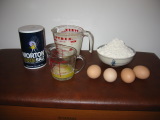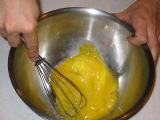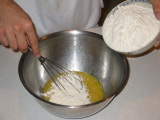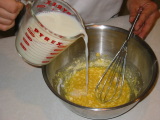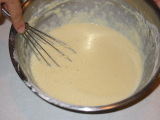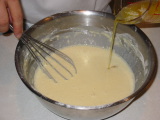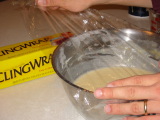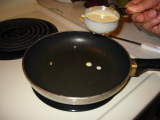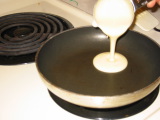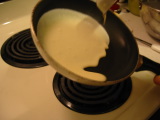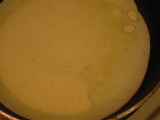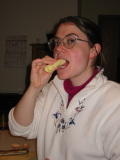Making Crepes
Making crepes is not hard. If you can make pancakes, you can make crepes.
It is no problem to make a half-batch or a double-batch. This recipe is adapted from Crepe Cookery, by Mable Hoffman. I learned it from my mother, who is an excellent crepe maker. I use a whisk, but a mixer or blender would certainly work just fine. I'm still not used to the novelty of mixers after years of not having one.
Note: You can click on any of the pictures to see a larger version.
Tips
Before we start, I have a few tips:- Don't worry about getting the thinnest possible crepes. I have had people tell me that when they make crepes, they aren't thin enough. Crepes don't need to be perfectly thin, and they often aren't. When I ate crepes from a street vendor in Paris, they were about the same thickness as the ones I make, and they were not thin as paper. Relax, your crepes are not too thick.
- You don't need a special crepe pan. You can buy very fancy skillets or electric pans. If you have a small non-stick skillet, you will get perfectly nice crepes, and you'll have one less pan crowding up your kitchen.
- You'll probably mess up a couple of the crepes when you make a batch. So what? I've made lots of crepes, and I still mess up at least one per batch. Sprinkle some sugar on it and enjoy it as a snack. Don't let it worry you.
- If you're making enough crepes to serve a lot of people, there are three easy ways to handle it. First, you can stick the crepes on a plate in a barely warm (200°F) oven, where they'll stay warm until you are ready to assemble them. Second, you can serve them as you make them. When serving family on a busy night, it's sometimes okay if people eat them as they are served. Third, it's not a big deal if the crepes cool down a little bit before you eat. If the filling is warm, it makes up for it.
Ingredients
To make about 20-24 crepes, you'll need a few ingredients:
- 4 eggs
- ¼ teaspoon salt
- 2 cups flour
- 2 ¼ cups milk
- ¼ cup (½ stick) melted butter
Utensils
- A whisk, wooden spoon, fork, electric mixer, or eggbeater
- A bowl to mix the crepe batter
- Plastic spatula
- 8 inch non-stick skillet
- A tupperware to store leftover bater
Making the Batter
At this point, your batter is ready to go, and you can begin making the crepes whenever you are ready. You can the batter a few hours or even a day in advance of when you make the crepes. If you let it sit for a long time, the butter will separate from the rest of the batter, but you just need to whisk it for ten seconds or so, and it will be ready to use. I've kept my batter for several days, and it has been fine. After a couple of days, the batter gets a bit darker in color, but the crepes still taste fine.
If I'm making the batter right before I make the crepes, I refrigerate the batter while I prepare the filling.
Cooking the Crepes
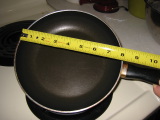 1. Select an eight inch non-stick skillet. You don't need a fancy
crepe pan. It's okay to make larger crepes if you want to, just use
more batter.
1. Select an eight inch non-stick skillet. You don't need a fancy
crepe pan. It's okay to make larger crepes if you want to, just use
more batter.
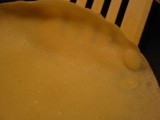 7. This is what the crepe looks like when it has set. Notice you can
see the spatula through the crepe, and this isn't a particularly thin crepe
either. The crepe will also usually slide around when it is ready. (It make
stick a bit a the edges though.)
7. This is what the crepe looks like when it has set. Notice you can
see the spatula through the crepe, and this isn't a particularly thin crepe
either. The crepe will also usually slide around when it is ready. (It make
stick a bit a the edges though.)
 10. After the second side has cooked for maybe twenty seconds, slip it
out of the pan onto a plate for serving, or into a baking dish that you
can put into a warmed (200°F) oven.
10. After the second side has cooked for maybe twenty seconds, slip it
out of the pan onto a plate for serving, or into a baking dish that you
can put into a warmed (200°F) oven.
Once you have prepared the crepes, you can fill them and eat them.
This web page is copyright © 2002 by Alain Roy. Please do not copy this page without his permission.
